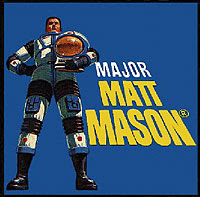 |
| Pat LeBlanc's Lunar Module Custom Part 3 - The Midsection |
I mentioned previously that the crew compartment was the most complicated shape of the ascent stage. I said that because I originally intended to model the midsection after the early concept (the all white LM) with round sides. However, after the amount of detail work I put into the crew compartment, I decided to
include the faceted surfaces surrounding the fuel tanks (anything worth doing is worth doing right).
 |
| Plexiglas Elevations |
Most of the exterior dimensions I used for the midsection were scaled up from the 1/48 scale LM. The interior dimensions came from the Lunar Module News Reference (LMNR). I started by transferring the outline of the midsection from the previously shown front elevation view onto 0.1" thick pieces of Plexiglas.
 |
| Interior Compartment |
At 1/12 scale, the distance between the front and back of the midsection is 5". I cut two 5" x 4.8" pieces of Plexiglas with 2.75" diameter holes to form the top of the midsection and the bottom of the docking tunnel. A block of Syrofoam is sandwiched between these pieces of Plexiglas to form the docking tunnel. The bottom of the docking tunnel is also the "roof" of the interior of the midsection. From the LMNR, the scaled down midsection interior should be approximately 5" tall, 5" wide and 5" deep. The next step was to cut Plexiglas to form the walls and floor of the midsection interior. The floor of the midsection interior is also the top of the ascent engine bay. This picture shows the walls and floor of the interior compartment and the docking tunnel attached to the front of the midsection.
 |
Fuel Tanks
|
After attaching the back, Plexiglas panels were used to form the bottom of the midsection. The next step was to cut and install blocks of balsa wood to form the outline of the faceted surfaces around the fuel tanks.
 |
Aligning the Parts
|
I installed magnets on the front of the midsection to match those on the back of the crew compartment. I also installed magnets on the bottom of the midsection that will match up to ones that will be installed in the descent stage.
 |
Faceted Components
|
Next came the laborious process of measuring the distances between the edges of Plexiglas and balsa wood to come up with the trapezoids and triangles to cover the open spaces. All pieces were first cut from construction paper for trial fitting and then cut from styrene for the final fit. The styrene panels are held in place with the same metallic duct tape I used on the crew compartment.
 |
Ascent Engines
|
I saved the pieces of construction paper from the previous step and used Elmer's glue to attach them to aluminum foil. Just like on the crew cabin, the paper smooths out most of the surface irregularities and makes the foil look like real sheets of aluminum.
I glued scrap pieces of balsa wood into one large piece and used my drill press to turn the block into the bell shape of the ascent engine. The ascent engine is 2.875" tall and about 2.5" in diameter at the bottom.
 |
Docking Tunnel
|
I used one of the 2.75" diameter circles left over from making the docking tunnel to make the top inner hatch. Like the hatch in the front of the crew cabin, a piece of Styrene was attached to the Plexiglas to form a lip seal. A piece of tape acts as a hinge. Two small pieces of a flat refrigerator magnet hold the hatch closed. According to several diagrams and the LMNR, the ascent engine cover extended inside the midsection. I was going to make the engine cover out of balsa wood but I noticed that the cap from a can of spray paint was just the right size so I glued it in the center of the midsection interior compartment. Here's a recreation from Apollo 15 of Dave Scott's "standup EVA" where he stood on the engine cover to survey the landing site.
 |
| Antennae |
The support struts for the S-band and VHF antennae are 3/16" and 1/8" wooden dowels covered with crumpled aluminum foil. The S-band antenna dish was turned from a piece of balsa wood. The rest of the antenna is Plexiglas.
 |
Docking Target
|
The two VHF antennae are made from straight pins and pieces of wire. I created the docking target using Freelance and used a 1/8" piece of wooden dowel for the post.
This model is obviously a departure from what Mattel would have produced in the 60's but once I started getting into the details it was hard to stop. To quote JFK:
"We choose to go to the moon. We choose to go to the moon in this decade and do
the other things, NOT BECAUSE THEY ARE EASY, BUT BECAUSE THEY ARE HARD, because
that goal will serve to organize and measure the best of our energies and skills,
because that challenge is one that we are willing to accept, one we are unwilling
to postpone, and one which we intend to win, and the others, too."
This model is my tribute not only to a childhood toy but to the Challenger 7, the Columbia 7, the crew of Apollo 1 and those serving around the world to protect America.
You can contact Pat through Facebook about his amazing custom here.
All Mattel images and captions are copyright Mattel and used without permission. All other content, including images and editorial, is Copyright © 1997-2023 John Eaton and/or contributors unless otherwise stated. If there are any comments or objections, please contact John Eaton.


















No comments:
Post a Comment